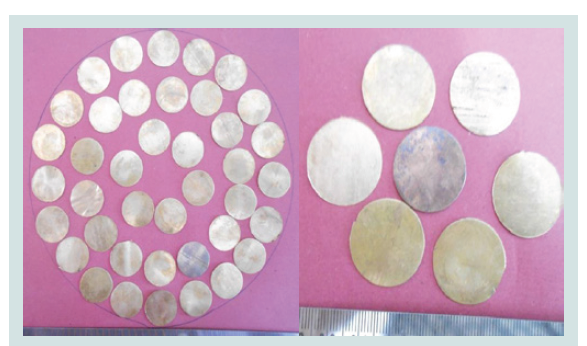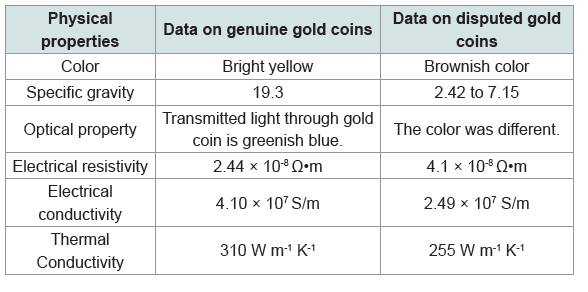Journal of Forensic Investigation
Download PDF
Case Report
Gold Coin Crime - A Case Report
Ajitesh Pal* and Pratihari HK
- Tripura State Forensic Science Laboratory, Agartala, India
*Address for Correspondence: Ajitesh Pal, Forensic Studies Program, Tripura State Forensic Science Laboratory, Agartala - 799015, India,; E-mail: ajiteshp@rediffmail.com
Citation: Pal A, Pratihari HK. Gold Coin Crime - A Case Report. J Forensic Investigation. 2017; 5(1): 2.
Copyright: © 2017 Pal A, et al. This is an open access article distributed under the Creative Commons Attribution License, which permits unrestricted use, distribution, and reproduction in any medium, provided the original work is properly cited.
Submission: 07 March, 2017 | Accepted: 26 April, 2017 | Published: 04 May, 2017
Journal of Forensic Investigation | ISSN: 2330-0396 | Volume: 5, Issue: 1
Abstract
Gold is sold in the form of coins, biscuits, bars, jewellery, artwork and watches since gold is one of the precious metals. Its value encourages the criminals to commit crimes like burglary, snatching cheating and even murder in different situation. In one case, an unscrupulous trader had some genuine gold coins along with some fake ones. He sold the genuine gold coin to a shopkeeper at low cost after rudimentary check. Winning the confidence of the buyer, he started selling fake coins too. The victim understood the forgery of the cheater and lodged a complaint to police. During investigation, the accused was nabbed and the coins were recovered from the victim and accused. Subsequently the coins were sent for forensic examination. The chemical test coupled with Karatmeter, SEM-EDX (Scanning Electron Microscopy with Energy Dispersive X-ray) analysis proved that the disputed coins were fake in this case.
Keywords:
Counterfeit; Gold coins; Physical properties; Karatmeter; SEM-EDX
Introduction
Among the various precious metals, gold is noteworthy. It has a strong fascination among the common people for thousands of years. India is the world’s largest consumer of gold and it is used in the form of coins, artwork, jewelry and watches [1]. In addition, gold also has a number of uses in industry, medicine, computer, electronics, dentistry, aerospace and other applications [2]. Indians traditionally hoard gold in the belief of bringing financial security. As per available record, crimes like theft, cheating, snatching even murder related to gold are frequently reported and investigated by the law enforcement agencies. The counterfeiters and goldsmith explore various methods for counterfeiting/stealing gold [2]:
- Electroplating of gold on cheap metals to appear like gold
- Making false stamp, hall marks on jewelry to appear real
- Counterfeiting coin with different metals showing all features of genuine coin
- Counterfeiting gold bars siphoning gold from inside that look real
- Coating of gold on lead/silver to make medals (fake)
- Stealing gold from jewelry with chemicals
In the present paper, some disputed gold coins have been examined by physical and chemical methods supported by instrumental studies like Karatmeter and SEM-EDX.
Case Report
In one case, an unscrupulous trader was selling handloom products in a village and convinced one shopkeeper about having some gold coins for sale. Further, he assured the shopkeeper to check the genuineness of the coins through local goldsmith. Being influenced, the shopkeeper got tempted to purchase some gold coins at low cost. Subsequently the shopkeeper came to know that the coins purchased were fake and lodged a complaint to police. During investigation the accused was apprehended and recovered the disputed coins from the victim and the accused. The seized coins were examined in the laboratory to ascertain the genuineness of the coins for further investigation.
Materials and Methods
The disputed gold coins received in the laboratory were cleaned thoroughly with detergent followed with dilute hydrochloric acid. The physical parameters such as diameter, thickness and weight of the coins were measured. The chemical analysis of the coins was carried out to ascertain the presence of gold and the elemental composition in the coins. In addition, the purity of the disputed coins was checked with Karatmeter (TATA group) followed by SEM-EDX (Oxford Inca EDX instrument system) study. Figure 1 shows the photograph of disputed gold coins.
Results and Discussion
The physical properties of genuine/disputed gold coins are shown in the Table 1.
The analysis of EDX graph shows the presence of 73.88% copper (Cu), 20.13% zinc (Zn) and 5.99% silicon. EDX study conclusively confirmed the absence of gold in disputed coins.
Conclusions
The physical and chemical analyses of the seized gold coins indicated the absence of gold. However, SEM-EDX and Karatmeter studies confirmed the elemental composition of the counterfeit coins. All the studies conclusively proved the absence of gold in the coins. The findings of the examination helped the investigating officer to proceed further in this case.




